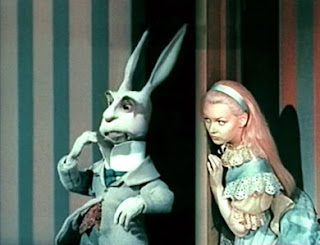From an early age I've always been taken by Alice's Adventures in Wonderland. Like The Lion, The Witch and the Wardrobe, I was fascinated with the idea of discovering a magical other-world by accident, when you least expect it, and would've given anything to have had it happen to me. As a budding artist, John Tenniel's illustrations captured my imagination as much as the story. I think I may have even tried to copy them for myself - freehand, of course. I know I tried making some originals.
 |
| Alice in Wonderland (1903) |
 |
| Alice in Wonderland (1931) |
The first film adaptation of Alice was a British silent from 1903, 38 years after the book was published. It was directed by Cecil Hepworth and Percy Stow and starred May Clark as Alice. The only surviving copy was partially restored and tinted by the British Film Institute. The costumes are nice, and the growing and shrinking effects are decent. The Cheshire Cat looks more like Grumpy Cat. The title cards describe scenes in a broad fashion but don't go into dialogue, so if one never read the book, I imagine they'd have a tough time making sense of it all - not that Alice makes much sense to begin with. One wonders what Georges Melies would've done with an Alice movie.
The first Alice talkie came out in 1931. It was an American production directed by Bud Pollard, starring Ruth Gilbert in a blond wig. It was shot over in Fort Lee, NJ. It's lousy. I couldn't finish watching it. Gilbert talks in a Betty Boop voice with a goofy expression on her face. Everyone over-enunciates, this being an early sound movie. It's shot like a stage play, which is to say, unimaginatively, and the screenplay is pedantically devoted to the book to the point where they may as well be reading from it directly. The one saving grace is the 20s-jazz-style theme song by Irving Berlin, of all people.
 |
| Alice Au Pays Des Merveilles (1949) |
Then there's the 1949 French Alice film, Alice Au Pays Des Merveilles, directed by Dallas Bower and starring Carol Marsh. This is a live-action/claymation hybrid. Marsh interacts with the stop-motion-animation puppets of Wonderland. Also, like Bride of Frankenstein, there's a framing sequence depicting the author of the original book, in this case, Carroll - or Dodgson, I should say, played by Stephen Murray. We see him in his job as a math teacher at Oxford University, meeting Queen Victoria and telling the Wonderland story to Alice Liddell, the real-life inspiration for the Alice character, and her sisters.
The claymation is terrific. I like the designs for the White Rabbit, the Cheshire Cat and the Mad Hatter. There are musical numbers adapted from the poems in the book that sound way better than the singing in the '31 version. The puppets sing, dance and emote well. Marsh captures Alice's befuddled innocence without being cloying, and she has a great singing voice. The film drags after awhile, as it becomes more about the Wonderland denizens and less about Alice, but it's still worth seeing for anyone who loves the book.
The Alice books are in the public domain, so one imagines storytellers across all media will continue reinterpreting them as long as it fires their imaginations.
----------------------------
Previously:
The Thin Man
A Tree Grows in Brooklyn

























